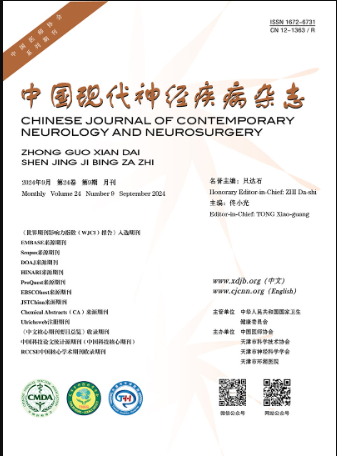Effect of early trunk control training on balance function of patients with acute stroke
Q4 Medicine
引用次数: 2
Abstract
Background Trunk is the core part of human body, and plays an important role in maintaining the body balance. Studies show that trunk control training can improve the balance function and mobility ability, and promote motor function and activities of daily living (ADL) of stroke patients. This study aims to investigate the effect of early trunk control training on the recovery of balance function of acute stroke patients. Methods A total of 120 patients with acute ischemic stroke (duration ≤ 14 d) were randomly divided into 2 groups: control group [N = 60, 39 males and 21 females; age 23-85 years, mean age (63.43 ± 13.61) years; duration 1-13 d, median duration 4.12 (2.30, 6.09) d] and observation group [N = 60, 40 males and 20 females; age 20-84 years, average age (62.55 ± 13.77) years; duration 1-12 d, median duration 4.19 (2.48, 6.30) d]. Control group was given routine drug treatment plus rehabilitation education and guidance, and observation group was given routine drug treatment, rehabilitation education and guidance plus trunk control training. Fugl-Meyer Assessment Scale-Balance (FMA-Balance) and Modified Rivermead Mobility Index (MRMI) were used to evaluate the balance function of patients in both groups before training and after 2-week training. Results All patients finished the rehabilitation training programme without adverse reactions. Compared with before training, the scores of FMA-Balance ( P =0.000) and MRMI ( P = 0.000) were significantly increased after 2-week training in both groups. Compared to control group, the scores of FMA-Balance ( P = 0.002) and MRMI ( P = 0.002) were significantly increased after 2-week training in observation group. Conclusions Early trunk control training can significantly improve the balance function and motor ability of patients with acute stroke. DOI: 10.3969/j.issn.1672-6731.2017.04.005早期躯干控制训练对急性脑卒中患者平衡功能的影响
躯干是人体的核心部位,对保持身体平衡起着重要的作用。研究表明,躯干控制训练可以改善脑卒中患者的平衡功能和活动能力,促进运动功能和日常生活活动能力。本研究旨在探讨早期躯干控制训练对急性脑卒中患者平衡功能恢复的影响。方法120例急性缺血性脑卒中患者(病程≤14 d)随机分为2组:对照组60例,男39例,女21例;年龄23 ~ 85岁,平均(63.43±13.61)岁;病程1 ~ 13 d,中位病程4.12 (2.30,6.09)d],观察组[N = 60,男40,女20];年龄20 ~ 84岁,平均年龄(62.55±13.77)岁;病程1 ~ 12 d,中位病程4.19 (2.48,6.30)d。对照组给予常规药物治疗+康复教育指导,观察组给予常规药物治疗+康复教育指导+主干控制训练。采用Fugl-Meyer平衡评估量表(FMA-Balance)和改良的Rivermead运动能力指数(MRMI)评估两组患者在训练前和训练2周后的平衡功能。结果所有患者均完成康复训练,无不良反应。与训练前比较,两组训练2周后FMA-Balance得分(P =0.000)和MRMI得分(P =0.000)均显著提高。与对照组相比,观察组患者训练2周后FMA-Balance评分(P = 0.002)和MRMI评分(P = 0.002)均显著升高。结论早期躯干控制训练可显著改善急性脑卒中患者的平衡功能和运动能力。DOI: 10.3969 / j.issn.1672-6731.2017.04.005
本文章由计算机程序翻译,如有差异,请以英文原文为准。
求助全文
约1分钟内获得全文
求助全文

 求助内容:
求助内容: 应助结果提醒方式:
应助结果提醒方式:


